Huawei Technologies AP8030DN Outdoor Wireless LAN Access Point User Manual Product Description
Huawei Technologies Co.,Ltd Outdoor Wireless LAN Access Point Product Description
users manual

AP8030DN
Product Description
Issue 05
Date 2017-04-20
HUAWEI TECHNOLOGIES CO., LTD.

Copyright © Huawei Technologies Co., Ltd.
Copyright © Huawei Technologies Co., Ltd. 2017. All rights reserved.
No part of this document may be reproduced or transmitted in any form or by any means without prior written
consent of Huawei Technologies Co., Ltd.
Trademarks and Permissions
and other Huawei trademarks are trademarks of Huawei Technologies Co., Ltd.
All other trademarks and trade names mentioned in this document are the property of their respective
holders.
Notice
The purchased products, services and features are stipulated by the contract made between Huawei and the
customer. All or part of the products, services and features described in this document may not be within the
purchase scope or the usage scope. Unless otherwise specified in the contract, all statements, information,
and recommendations in this document are provided "AS IS" without warranties, guarantees or
representations of any kind, either express or implied.
The information in this document is subject to change without notice. Every effort has been made in the
preparation of this document to ensure accuracy of the contents, but all statements, information, and
recommendations in this document do not constitute a warranty of any kind, express or implied.
Huawei Technologies Co., Ltd.
Address: Huawei Industrial Base
Bantian, Longgang
Shenzhen 518129
People's Republic of China
Website: http://e.huawei.com
Issue 05 (2017-04-20) Huawei Proprietary and Confidential i

AP8030DN
Product Description
About This Document
Issue 05 (2017-04-20)
Huawei Proprietary and Confidential
Copyright © Huawei Technologies Co., Ltd.
ii
About This Document
Purpose
This document describes the positioning, characteristics, hardware structure, product features,
and technical specifications of the AP.
This document helps you understand the characteristics and features of the AP.
Intended Audience
This document is intended for network engineers responsible for network design and
deployment. You should understand your network well, including the network topology and
service requirements.
Symbol Conventions
The symbols that may be found in this document are defined as follows.
Symbol
Description
Indicates an imminently hazardous situation
which, if not avoided, will result in death or
serious injury.
Indicates a potentially hazardous situation
which, if not avoided, could result in death
or serious injury.
Indicates a potentially hazardous situation
which, if not avoided, may result in minor
or moderate injury.
Indicates a potentially hazardous situation
which, if not avoided, could result in
equipment damage, data loss, performance
deterioration, or unanticipated results.
NOTICE is used to address practices not
related to personal injury.

AP8030DN
Product Description
About This Document
Issue 05 (2017-04-20)
Huawei Proprietary and Confidential
Copyright © Huawei Technologies Co., Ltd.
3
Symbol
Description
NOTE
Calls attention to important information,
best practices and tips.
NOTE is used to address information not
related to personal injury, equipment
damage, and environment deterioration.
Change History
Changes between document issues are cumulative. The latest document issue contains all the
changes made in previous issues.
Changes in Issue 05 (2017-04-20)
This version has the following updates:
The following information is modified:
3.3 QoS Features
Changes in Issue 04 (2016-10-15)
This version has the following updates:
The following information is added:
4 Product Features (in Cloud-based Management Mode)
The following information is modified:
1.1 Product Positioning
5.1 Basic Specifications
Changes in Issue 03 (2015-07-15)
This version has the following updates:
The following information is modified:
5.2 Radio Specifications
Changes in Issue 02 (2014-12-05)
This version has the following updates:
The following information is modified:
5.2 Radio Specifications
Changes in Issue 01 (2014-09-10)
This is the initial commercial release.

Issue 05 (2017-04-20)
Huawei Proprietary and Confidential
Copyright © Huawei Technologies Co., Ltd.
4
AP8030DN
Product Description
Contents
Contents
About This Document ............................................................................................................ ii
1 Product Positioning and Characteristics ............................................................................ 1
1.1 Product Positioning............................................................................................................................................................... 1
1.2 Product Characteristics ......................................................................................................................................................... 7
2 Hardware Structure. ........................................................................................................... 10
2.1 AP8030DN ......................................................................................................................................................................... 10
3 Product Features (in Fat AP and Fit AP Modes) .............................................................. 16
3.1 WLAN Features. ................................................................................................................................................................ 16
3.2 Network Features. .............................................................................................................................................................. 17
3.3 QoS Features. ..................................................................................................................................................................... 17
3.4 Security Features ............................................................................................................................................................... 17
3.5 Maintenance Features ........................................................................................................................................................ 18
3.6 BYOD ................................................................................................................................................................................. 18
3.7 Locating Service ................................................................................................................................................................ 19
3.8 Spectrum Analysis. ............................................................................................................................................................ 19
4 Product Features (in Cloud-based Management Mode) ................................................. 20
5 Technical Specifications .................................................................................................... 24
5.1 Basic Specifications ........................................................................................................................................................... 24
5.2 Radio Specifications .......................................................................................................................................................... 25
5.3 Standards Compliance ....................................................................................................................................................... 32

AP8030DN
Product Description
1 Product Positioning and Characteristics
Issue 05 (2017-04-20)
Huawei Proprietary and Confidential
Copyright © Huawei Technologies Co., Ltd.
1
1Product Positioning and Characteristics
1.1 Product Positioning
Table 1-1 Product positioning
Product
Model
Frequency
Band
IEEE
Standard
Compliance
Positioning
Usage
Scenario
AP8030DN
Dual band:
2.4 GHz
5 GHz
The AP8030DN
can provide
services
simultaneously
on the 2.4 GHz
and 5 GHz
frequency
bands to
support more
access users.
IEEE
802.11a/b/g/n/a
c
Huawei
AP8030DN is
the latest
802.11ac
outdoor dual-
band wireless
access point
(AP).
Physically
hardened, the
AP8030DN
supports 3x3
MIMO and
offers enhanced
outdoor
coverage
performance. It
can provide
services
simultaneously
on the 2.4 GHz
and 5 GHz
frequency
bands to
support more
access users. It
also provides
comprehensive
Huawei
AP8030DNs
comply with
IP67 dustproof
and waterproof
protection
standards,
applicable to
coverage
scenarios (for
example,
squares,
pedestrian
streets, and
amusement
parks) and
bridging
scenarios (for
example,
wireless
harbors, data
backhaul, video
surveillance,
and train-to-
ground
backhaul).

AP8030DN
Product Description
1 Product Positioning and Characteristics
Issue 05 (2017-04-20)
Huawei Proprietary and Confidential
Copyright © Huawei Technologies Co., Ltd.
2
Product
Model
Frequency
Band
IEEE
Standard
Compliance
Positioning
Usage
Scenario
service support
capabilities and
features high
reliability, high
security, simple
network
deployment,
automatic AC
discovery and
configuration,
and real-time
management
and
maintenance,
which meets
requirements of
outdoor
deployment.
The AP8030DN can work as a Fat AP, Fit AP, or cloud AP. It can switch flexibly among three
working modes based on the network plan.
Typical networking modes are as follows:
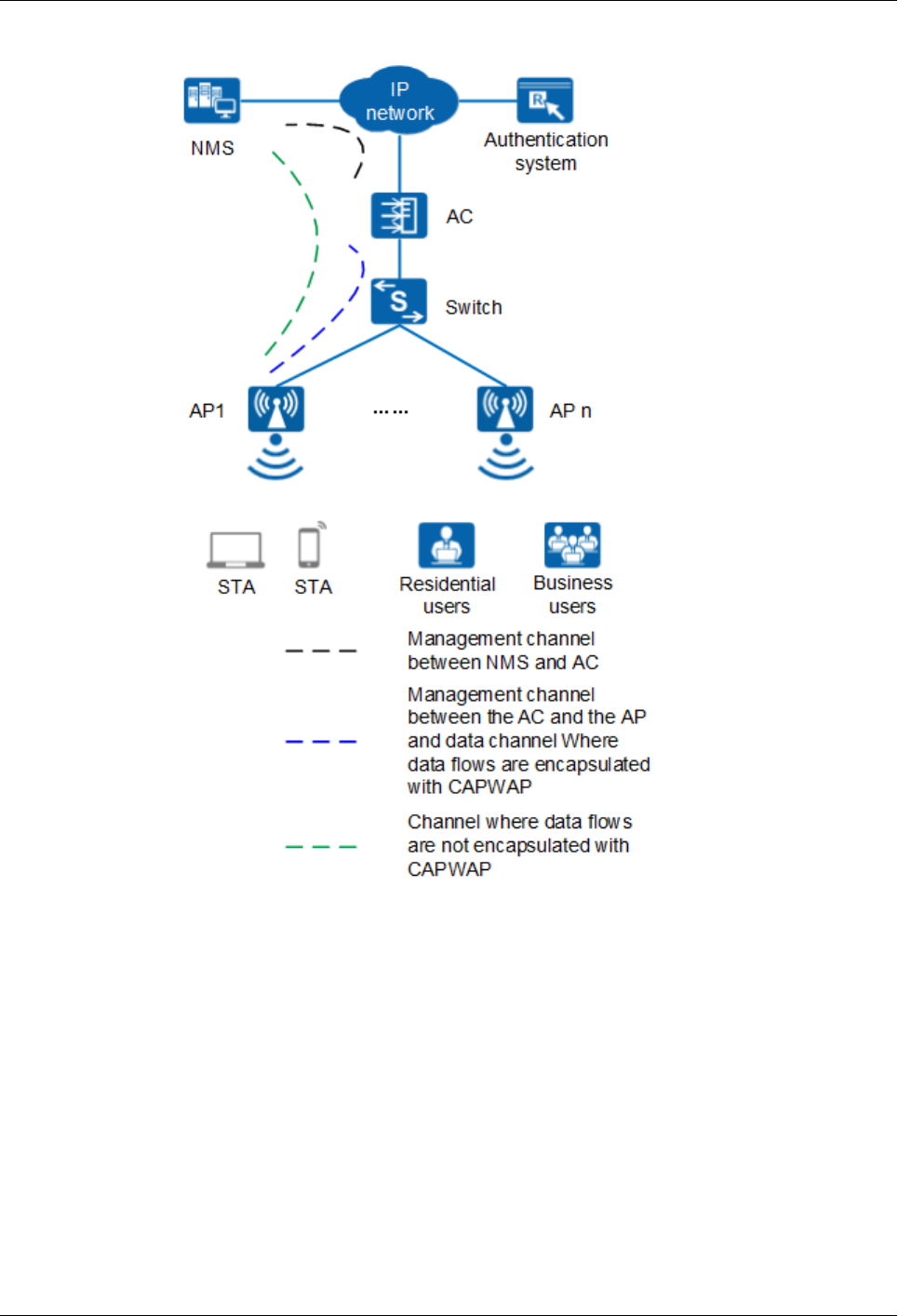
AP8030DN
Product Description
1 Product Positioning and Characteristics
Issue 05 (2017-04-20)
Huawei Proprietary and Confidential
Copyright © Huawei Technologies Co., Ltd.
3
Figure 1-1 Fit AP networking (AP mode)
In this networking, the AP functions as a Fit AP. The AC is responsible for user access, AP
go-online, AP management, authentication, routing, security, and QoS. Huawei products that
provide the AC function include the AC6605, AC6005, ACU2 (with S7700, S9700, or
S12700), S5720HI, S6720HI, S7700 (with X series board), S9700 (with X series board), and
S12700 (with X series board).
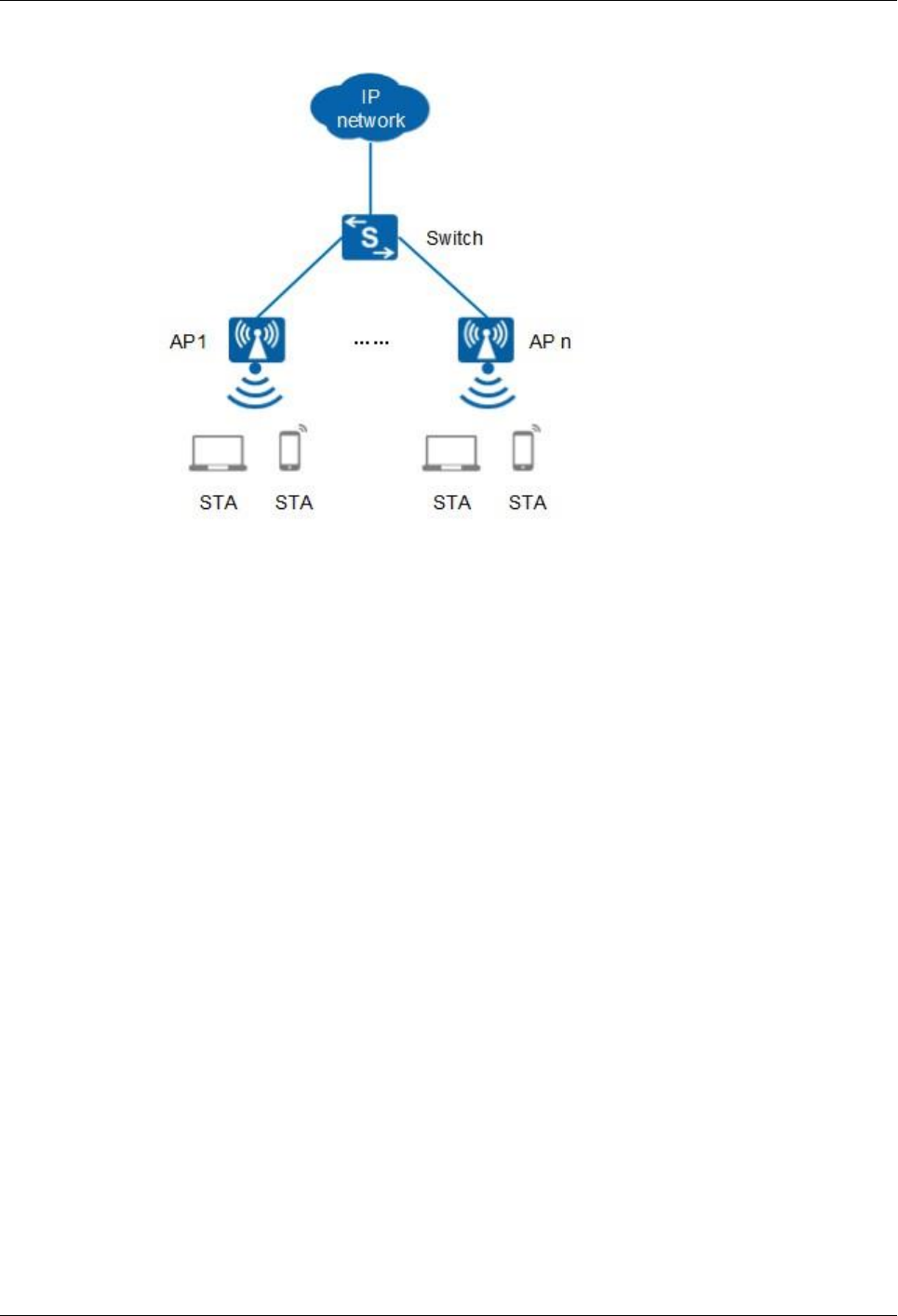
AP8030DN
Product Description
1 Product Positioning and Characteristics
Issue 05 (2017-04-20)
Huawei Proprietary and Confidential
Copyright © Huawei Technologies Co., Ltd.
4
Figure 1-2 Fat AP networking
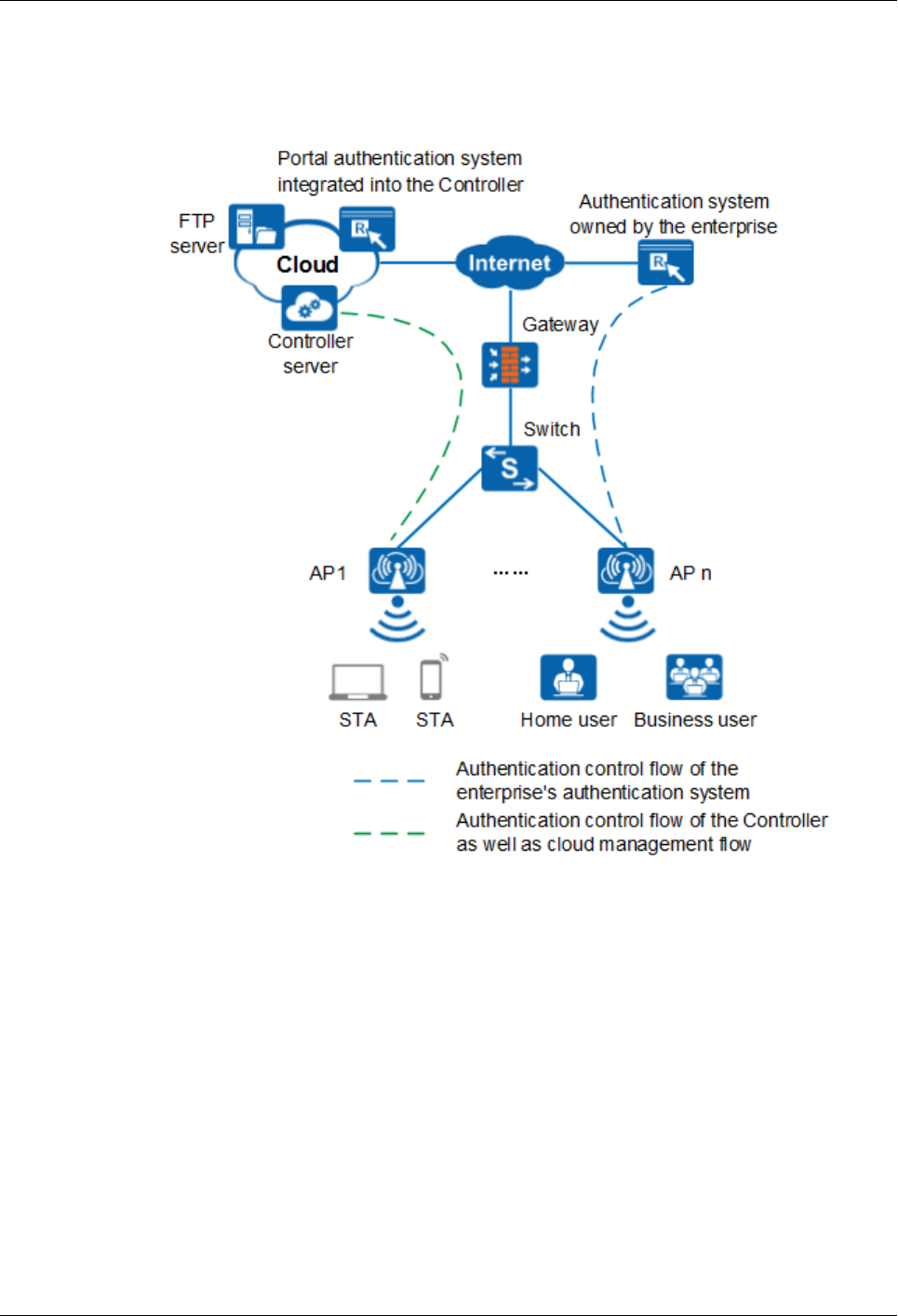
AP8030DN
Product Description
1 Product Positioning and Characteristics
Issue 05 (2017-04-20)
Huawei Proprietary and Confidential
Copyright © Huawei Technologies Co., Ltd.
5
In this networking, the device functions as a Fat AP to implement functions such as user
access, authentication, data security, service forwarding, and QoS.
Figure 1-3 Cloud AP networking
In this networking, the device functions as a cloud AP and works with the Agile Controller-
Campus on the same cloud for user access, AP online, authentication, routing, AP
management, security, and QoS. An enterprise can choose to use the Portal authentication
server integrated in the Agile Controller-Campus or the authentication server deployed by
itself.

AP8030DN
Product Description
1 Product Positioning and Characteristics
Issue 05 (2017-04-20)
Huawei Proprietary and Confidential
Copyright © Huawei Technologies Co., Ltd.
6
1.2 Product Characteristics
Product
Characteristics
Description
High-speed and
Complies with IEEE 802.11a/b/g/n/ac.
reliable wireless
access
Supports 3x3 MIMO and provides a maximum rate of 1.75 Gbit/s.
Supports Wi-Fi Multimedia (WMM) and priority mapping on the
air interface and wired interface.
Supports wired link integrity check.
Provides two GE auto-sensing uplink electrical ports and supports
PoE power supply.
Supports load balancing.
Supports roaming without service interruption in Fit AP mode.
Supports AC dual-link backup in Fit AP mode.
Uses the latest 802.11ac chip to provide higher performance and
wider coverage.
Uses a metal shell and heat dissipation design to ensure high
reliability.
Supports airtime scheduling which ensures fairness in channel
occupation time for all users.
Comprehensive
Supports access control lists (ACLs) and implements user access
user access control
control based on the user group policy.
capability
Provides fine-grained bandwidth management for each user.
Supports user isolation policies.
Supports unified authentication on the AC in Fit AP mode.
Identifies the device type according to the organizationally unique
identifier (OUI) in the MAC address, user agent (UA) information
in an HTTP packet, and DHCP options in Fit AP mode.
The RADIUS server delivers packet forwarding, security, and
QoS policies according to the device type carried in the RADIUS
authentication and accounting packets in Fit AP mode.

AP8030DN
Product Description
1 Product Positioning and Characteristics
Issue 05 (2017-04-20)
Huawei Proprietary and Confidential
Copyright © Huawei Technologies Co., Ltd.
7
Product
Characteristics
Description
High network
security
Open system authentication
WEP authentication/encryption
WPA/WPA2/WPA-WPA2-PSK authentication and encryption
WPA/WPA2/WPA-WPA2-802.1x authentication and encryption
WPA, WPA2, and WPA-WPA2 support TKIP and CCMP
encryption algorithms, where CCMP uses 128-bit advanced
encryption standard (AES) encryption algorithm and has high
security.
WAPI authentication and encryption
Supports wireless intrusion detection system (WIDS) and wireless
intrusion prevention system (WIPS), including rogue device
detection and countermeasure, attack detection and dynamic
blacklist, STA/AP blacklist and whitelist.
Flexible
networking and
environment
adaptability
Provides flexible networking capabilities and applies to
various application scenarios. Mesh and WDS scenarios are
supported only in Fit AP mode.
Has strong environment adaptability. The AP can automatically
select the transmission rates, channels, and transmit power to
adapt to various radio environments and avoid interference in real
time.
Adjusts bandwidth allocation based on the user quantity
and environment to improve user experience.
Supports the MIMO antenna system.
Identifies interference sources such as baby monitors, Bluetooth
devices, digital cordless phones (at 2.4 GHz frequency band only),
wireless audio transmitters (at both the 2.4 GHz and 5 GHz
frequency bands), wireless game controllers, and microwaves in
Fit AP mode and works with eSight to display spectrums of
interference sources.
Easy device
management and
maintenance
Automatically goes online and loads the configuration,
and supports plug-and-play (PnP) in Fit AP mode.
Supports batch upgrade.
Manages APs locally on the web platform and supports HTTP
or HTTPS login, configuration, and maintenance in Fat AP
mode.
Allows real-time monitoring on the network management
system (NMS) to facilitate remote configuration and fast fault
location.
Supports the Link Layer Discovery Protocol (LLDP) to
implement automatic link discovery and obtain the network
topology.

AP8030DN
Product Description
1 Product Positioning and Characteristics
Issue 05 (2017-04-20)
Huawei Proprietary and Confidential
Copyright © Huawei Technologies Co., Ltd.
8
Product
Characteristics
Description
High reliability
and protection
level
Provides strong hardware protection capability.
Adapts to a wide temperature range from -40°C to +65°C.
Uses industry-standard components and design methods,
improving industry-level reliability.
Complies with IP67 protection standards.
Provides 6 kA or 6 kV surge protection capability on an Ethernet
interface.
Complies with international standards and China safety
standards III.
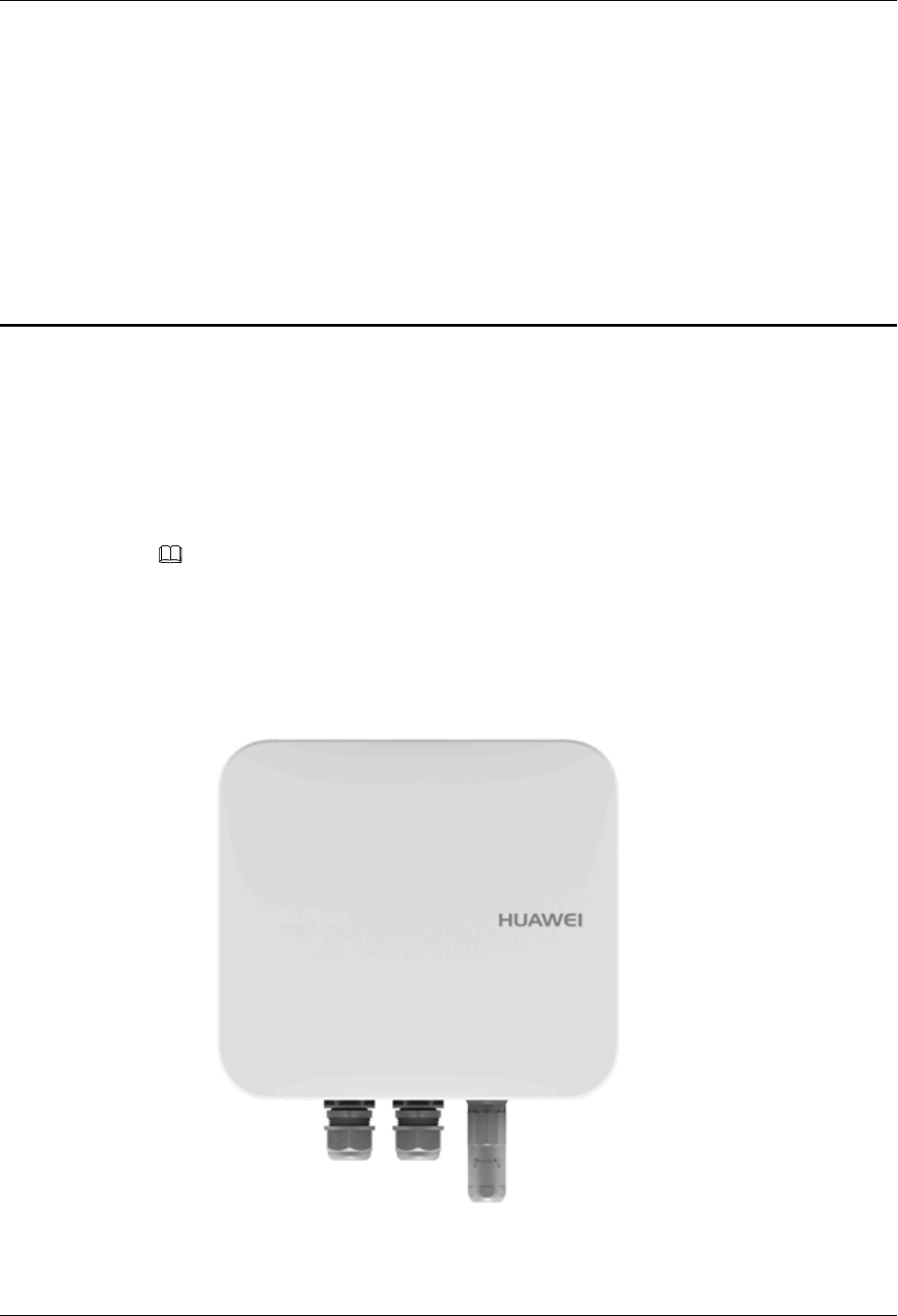
Issue 05 (2017-04-20)
Huawei Proprietary and Confidential
Copyright © Huawei Technologies Co., Ltd.
9
AP8030DN
Product Description
2 Hardware Structure
2Hardware Structure
2.1 AP8030DN
Appearance
Figure 2-1 shows the appearance of the AP.
NOTE
The actual device appearance may be different from the following device appearance, but these
differences will not affect device functions.
Figure 2-1 AP appearance
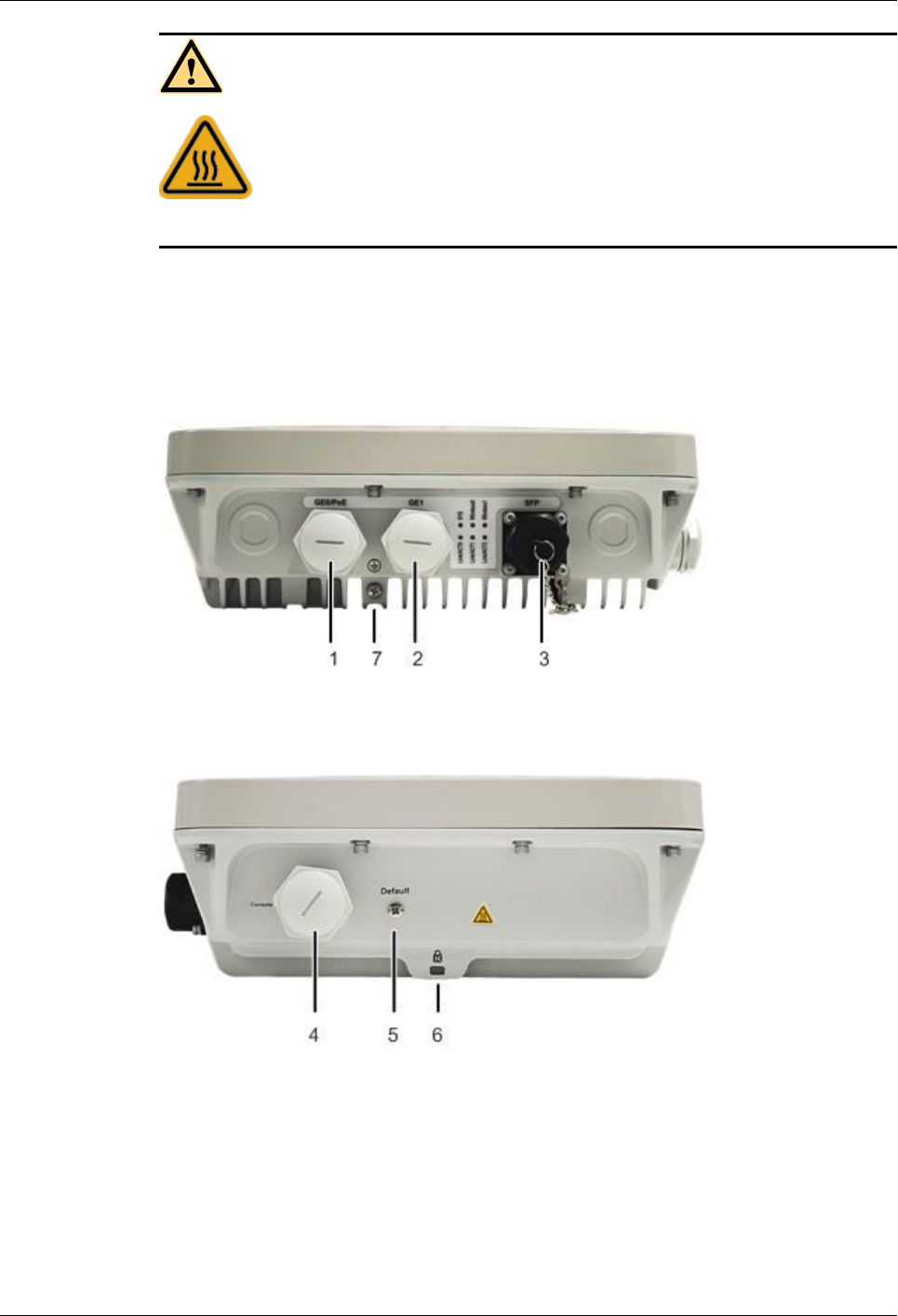
Issue 05 (2017-04-20)
Huawei Proprietary and Confidential
Copyright © Huawei Technologies Co., Ltd.
10
AP8030DN
Product Description
2 Hardware Structure
CAUTION
There is a scald warning label attached on the device, warning you not to touch
the device after the device has been operating for a long time.
Interfaces
The following figure shows interfaces on the AP.
Figure 2-2 Interfaces on the AP
1. GE0/PoE interface: 10/100/1000M port that connects to the wired Ethernet and supports
PoE input.
2. GE1 interface: 10/100/1000M port that connects to the wired Ethernet.
3. SFP: Optical port that supports the 100M/1000M optical module.
4. CONSOLE: Connects to a maintenance terminal for AP configuration and management.
5. Default:Restores factory settings and restarts the device when you hold down the button
more than 3 seconds.

Issue 05 (2017-04-20)
Huawei Proprietary and Confidential
Copyright © Huawei Technologies Co., Ltd.
11
AP8030DN
Product Description
2 Hardware Structure
Link/A C T0
Link/A C T1
Link/A C T2
SYS
W
ireless0
W
ireless1
NOTE
The Reset button is protected by a waterproof screw. Before pressing the Reset button, remove the
waterproof screw. Keep the screw properly and install it again after pressing the Reset button.
6. Security slot: Connects to a security lock.
7. Device ground screw: Connects the AP to a ground cable.
LED Indicators
The AP provides multiple indicators: SYS indicator, Link/ACT indicator, and Wireless
indicator. The following table describes indicators on AP.
NOTE
Indicator colors may vary slightly at different temperature.
GE1
Table 2-1 Descriptions about the SYS indicator
Type
Color
Status
Description
Default status after
power-on
Green
Steady on
The AP is just
powered on and the
software is not
started yet.
Software startup
status
Green
Steady on after
blinking once
After the system is
reset and starts
uploading the
software, the
indicator blinks
green once. Until the
software is uploaded
and started, the
indicator remains
steady green.

Issue 05 (2017-04-20)
Huawei Proprietary and Confidential
Copyright © Huawei Technologies Co., Ltd.
12
AP8030DN
Product Description
2 Hardware Structure
Type
Color
Status
Description
Running status
Green
Blinking once every
2s (0.5 Hz)
The system is
running properly,
the Ethernet
connection is
normal, and
STAs are
associated with
the AP.
The system
enters the Uboot
CLI.
Blinking once every
5s (0.2 Hz)
The system is
running properly, the
Ethernet connection
is normal, and no
STA is associated
with the AP. The
system is in low
power consumption
state.
Alarm
Green
Blinking once every
0.25s (4 Hz)
The software is
being upgraded.
After the
software is
loaded and
started, the AP
requests to go
online if it works
in Fit AP or
cloud-based
management
mode. The
indicator remains
in this state
before the AP
successfully goes
online.
The AP works
in Fit AP or
cloud- based
management
mode and fails to
go online.

Issue 05 (2017-04-20)
Huawei Proprietary and Confidential
Copyright © Huawei Technologies Co., Ltd.
13
AP8030DN
Product Description
2 Hardware Structure
Type
Color
Status
Description
Fault
Red
Steady on
A fault that affects
services has
occurred, such as a
DRAM detection
failure or system
software loading
failure. The fault
cannot be
automatically
rectified and must be
rectified manually.
Link/ACT indicators consist of Link/ACT0, Link/ACT1, and Link/ACT2, showing link status
of interfaces GE0/PoE, GE1, SFP respectively.
Table 2-2 Descriptions about the Link/ACT indicator
Type
Color
Status
Description
LINK
Green
Steady on
The system is running properly, the Ethernet
connection is normal, and no data is being
transmitted.
ACT
Green
Blinking
The system is running properly, the Ethernet
connection is normal, and the AP is transmitting
data. The indicator blinks more quickly when more
data is being transmitted.
Wireless indicators consist of Wireless0 and Wireless1, showing wireless link status of the
2.4/5 GHz and 5 GHz radio interfaces respectively.
Table 2-3 Description about the Wireless indicator (Traffic volume indicator)
Color
Status
Description
Green/yellow
Off
Radios are disabled, and no STA is
connected to the AP.
Green/yellow
Steady on
The AP has STAs connected to the 2.4 GHz
radio or 5 GHz radio, but no data is being
transmitted.
Green
Blinking
The AP has STAs connected to the 2.4 GHz
radio and is transmitting data. The indicator
blinks more quickly when more data is
being transmitted.

Issue 05 (2017-04-20)
Huawei Proprietary and Confidential
Copyright © Huawei Technologies Co., Ltd.
14
AP8030DN
Product Description
2 Hardware Structure
Color
Status
Description
Yellow
Blinking
The AP has STAs connected to the 5 GHz
radio and is transmitting data. The indicator
blinks more quickly when more data is
being transmitted.
Green/yellow
Blinking
alternatively
The AP has STAs connected to both the 2.4
GHz radio and 5 GHz radio. The indicator
blinks more quickly when more data is
being transmitted.
Table 2-4 Description about the Wireless indicator (Wireless bridge indicator)
Color
Status
Description
Green/yellow
Off
The AP is not transmitting or receiving data
or the signal strength is extremely low.
Blinking once every
2s (0.5 Hz)
The AP is transmitting or receiving data
normally, and the signal strength is low.
Blinking once every
0.25 seconds (4 Hz)
The AP is transmitting or receiving data
normally, and the signal strength is medium.
Steady on
The AP is transmitting or receiving data
normally, and the signal strength is high.
NOTE
When the WDS/Mesh function is enabled on an AP, the blinking frequency of its Wireless indicator
indicates the receive signal strength on the WDS/Mesh connection by default. After you connect an AP
to a WDS/Mesh network, you can run the wifi-light { signal-strength | traffic } command on the AC to
specify whether the Wireless indicator blinking frequency indicates the receive signal strength or service
traffic rate.
wifi-light signal-strength:
If the Mesh function is enabled on the AP, the blinking frequency of the Wireless indicator
reflects the weakest signal strength of all neighboring APs.
If WDS is enabled on an AP, the blinking frequency of the Wireless indicator reflects the
strength of signals received from a WDS AP.
If the AP works in leaf mode, the blinking frequency of the Wireless indicator reflects
the strength of signals received from a middle AP.
If the AP works in middle mode, the blinking frequency of the Wireless indicator
reflects the strength of signals received from a root AP.
If the AP works in root mode, the blinking frequency of the Wireless indicator reflects
the weakest signal strength of middle APs.
wifi-light traffic: allows the Wireless indicator to reflect the service traffic volume on the radio.
When an AP functions as a Fat AP, the Wireless indicator of the AP cannot reflect the signal strength.

Issue 05 (2017-04-20)
Huawei Proprietary and Confidential
Copyright © Huawei Technologies Co., Ltd.
15
AP8030DN
Product Description
3 Product Features (in Fat AP and Fit AP Modes)
3Product Features (in Fat AP and Fit AP
Modes)
3.1 WLAN Features
WLAN features supported by the AP are as follows:
Complies with IEEE 802.11a/b/g/n/ac, supports 3x3 MIMO, and provides a maximum
rate of 1.75 Gbit/s.
Maximum ratio combining (MRC)
Space time block code (STBC)
Low-density parity-check (LDPC)
Maximum-likelihood detection (MLD)
Frame aggregation, including A-MPDU (Tx/Rx) and A-MSDU (Tx/Rx)
802.11 dynamic frequency selection (DFS)
Short guard interval (GI) in 20 MHz, 40 MHz, and 80 MHz modes
Priority mapping and packet scheduling based on a Wi-Fi Multimedia (WMM) profile to
implement priority-based data processing and forwarding
Automatic and manual rate adjustment
WLAN channel management and channel rate adjustment
NOTE
For details about WLAN channel management, see the Country Code & Channel Compliance
Table.
Automatic channel scanning and interference avoidance
Service set identifier (SSID) hiding
Signal sustain technology (SST)
Unscheduled automatic power save delivery (U-APSD)
Control and Provisioning of Wireless Access Points (CAPWAP) in Fit AP mode
Automatic login in Fit AP mode
Extended Service Set (ESS) in Fit AP mode
Wireless distribution system (WDS) in Fit AP mode

Issue 05 (2017-04-20)
Huawei Proprietary and Confidential
Copyright © Huawei Technologies Co., Ltd.
16
AP8030DN
Product Description
3 Product Features (in Fat AP and Fit AP Modes)
Mesh networking in Fit AP mode
Multi-user CAC
3.2 Network Features
Network features supported by the AP are as follows:
Compliance with IEEE 802.3ab
Auto-negotiation of the rate and duplex mode and automatic switchover between the
Media Dependent Interface (MDI) and Media Dependent Interface Crossover (MDI-X)
Compliance with IEEE 802.1q
SSID-based VLAN assignment
VLAN trunk on uplink Ethernet ports
Management channel of the AP uplink port in tagged and untagged mode
DHCP client, obtaining IP addresses through DHCP
Tunnel data forwarding and direct data forwarding
STA isolation in the same VLAN
Access control lists (ACLs)
Link Layer Discovery Protocol (LLDP)
Uninterrupted service forwarding upon CAPWAP channel disconnection in Fit AP mode
Unified authentication on the AC in Fit AP mode
AC dual-link backup in Fit AP mode
Network Address Translation (NAT) in Fat AP mode
IPv6 in Fit AP mode
3.3 QoS Features
QoS features supported by the AP are as follows:
Priority mapping and packet scheduling based on a Wi-Fi Multimedia (WMM) profile to
implement priority-based data processing and forwarding
WMM parameter management for each radio
WMM power saving
Priority mapping for upstream packets and flow-based mapping for downstream packets
Queue mapping and scheduling
User-based bandwidth limiting
Adaptive bandwidth management (automatic bandwidth adjustment based on the user
quantity and radio environment) to improve user experience
Airtime scheduling
Smart Application Control (SAC) in Fit AP mode
3.4 Security Features
Security features supported by the AP are as follows:

Issue 05 (2017-04-20)
Huawei Proprietary and Confidential
Copyright © Huawei Technologies Co., Ltd.
17
AP8030DN
Product Description
3 Product Features (in Fat AP and Fit AP Modes)
Open system authentication
WEP authentication/encryption using a 64-bit, 128-bit, or 152-bit encryption key
WPA/WPA2-PSK authentication and encryption (WPA/WPA2 personal edition)
WPA/WPA2-802.1x authentication and encryption (WPA/WPA2 enterprise edition)
WPA-WPA2 hybrid authentication
WAPI authentication and encryption
Wireless intrusion detection system (WIDS) and wireless intrusion prevention system
(WIPS), including rogue device detection and countermeasure, attack detection and
dynamic blacklist, and STA/AP blacklist and whitelist
802.1x authentication, MAC address authentication, and Portal authentication
DHCP snooping
Dynamic ARP Inspection (DAI)
IP Source Guard (IPSG)
3.5 Maintenance Features
Maintenance features supported by the AP are as follows:
Unified management and maintenance on the AC in Fit AP mode
Automatic login and configuration loading, and plug-and-play (PnP) in Fit AP mode
WDS zero-configuration deployment in Fit AP mode
Mesh network zero-configuration deployment in Fit AP mode
Batch upgrade in Fit AP mode
Telnet
STelnet using SSH v2
SFTP using SSH v2
Web local AP management through HTTP or HTTPS in Fat AP mode
Real-time configuration monitoring and fast fault location using the NMS
SNMP v1/v2/v3 in Fat AP mode
System status alarm
Network Time Protocol (NTP) in Fat AP mode
Dying Gasp
3.6 BYOD
NOTE
The AP supports bring your own device (BYOD) only in Fit AP mode.
BYOD features supported by the AP are as follows:
Identifies the device type according to the organizationally unique identifier (OUI) in the
MAC address.
Identifies the device type according to the user agent (UA) information in an HTTP
packet.

Issue 05 (2017-04-20)
Huawei Proprietary and Confidential
Copyright © Huawei Technologies Co., Ltd.
18
AP8030DN
Product Description
3 Product Features (in Fat AP and Fit AP Modes)
Identifies the device type according to DHCP options.
The RADIUS server delivers packet forwarding, security, and QoS policies according to
the device type carried in the RADIUS authentication and accounting packets.
3.7 Locating Service
NOTE
The AP supports the locating service only in Fit AP mode.
Locating service features supported by the AP are as follows:
Locates tags manufactured by AeroScout or Ekahau.
Locates Wi-Fi terminals.
Works with eSight to locate rogue devices.
3.8 Spectrum Analysis
NOTE
The AP supports spectrum analysis only in Fit AP mode.
Spectrum analysis features supported by the AP are as follows:
Identifies interference sources such as baby monitors, Bluetooth devices, digital cordless
phones (at 2.4 GHz frequency band only), wireless audio transmitters (at both the 2.4
GHz and 5 GHz frequency bands), wireless game controllers, and microwaves.
Works with eSight to perform spectrum analysis on interference sources.

Issue 05 (2017-04-20)
Huawei Proprietary and Confidential
Copyright © Huawei Technologies Co., Ltd.
19
AP8030DN
Product Description
4 Product Features (in Cloud-based Management Mode)
4Product Features (in Cloud-based
Management Mode)
The following table lists features supported by APs in cloud-based management mode.

Issue 05 (2017-04-20)
Huawei Proprietary and Confidential
Copyright © Huawei Technologies Co., Ltd.
20
AP8030DN
Product Description
4 Product Features (in Cloud-based Management Mode)
Features
Description
WLAN Features
Compliance with IEEE 802.11a/b/g/n/ac
Maximum rate of 1.75 Gbit/s
Maximum ratio combining (MRC)
Space time block code (STBC)
Beamforming
Low-density parity-check (LDPC)
Maximum-likelihood detection (MLD)
Frame aggregation, including A-MPDU
(Tx/Rx) and A-MSDU (Tx/Rx)
802.11 dynamic frequency selection
(DFS)
Priority mapping and packet scheduling
based on a Wi-Fi Multimedia (WMM)
profile to implement priority-based data
processing and forwarding
WLAN channel management and
channel rate adjustment
NOTE
For details about WLAN channel
management, see the Country Code &
Channel Compliance Table.
Automatic channel scanning and
interference avoidance
Service set identifier (SSID) hiding
Signal sustain technology (SST)
Unscheduled automatic power save
delivery (U-APSD)
Automatic login
Network Features
Compliance with IEEE 802.3ab
Auto-negotiation of the rate and duplex
mode and automatic switchover between
the Media Dependent Interface (MDI)
and Media Dependent Interface
Crossover (MDI-X)
Compliance with IEEE 802.1q
SSID-based VLAN assignment
DHCP client, obtaining IP addresses
through DHCP
STA isolation in the same VLAN
Access control lists (ACLs)
Unified authentication on the Agile
Controller-Campus
Network Address Translation (NAT)

Issue 05 (2017-04-20)
Huawei Proprietary and Confidential
Copyright © Huawei Technologies Co., Ltd.
21
AP8030DN
Product Description
4 Product Features (in Cloud-based Management Mode)
Features
Description
QoS Features
Priority mapping and packet scheduling
based on a Wi-Fi Multimedia (WMM)
profile to implement priority-based data
processing and forwarding
WMM parameter management for each
radio
WMM power saving
Priority mapping for upstream packets
and flow-based mapping for downstream
packets
Queue mapping and scheduling
User-based bandwidth limiting
Airtime scheduling
Security Features
Open system authentication
WEP authentication/encryption using a
64-bit, 128-bit, or 152-bit encryption key
WPA2-PSK authentication and
encryption (WPA2 personal edition)
WPA2-802.1x authentication and
encryption (WPA2 enterprise edition)
WPA-WPA2 hybrid authentication
802.1x authentication, MAC address
authentication, and Portal authentication
DHCP snooping
Dynamic ARP Inspection (DAI)
IP Source Guard (IPSG)

Issue 05 (2017-04-20)
Huawei Proprietary and Confidential
Copyright © Huawei Technologies Co., Ltd.
22
AP8030DN
Product Description
4 Product Features (in Cloud-based Management Mode)
Features
Description
Maintenance Features
Unified management and maintenance
on the Agile Controller-Campus
Automatic login and
configuration loading, and plug-
and-play (PnP)
Batch upgrade
Telnet
STelnet using SSH v2
SFTP using SSH v2
Local AP management through the
serial interface
Web local AP management
through HTTP or HTTPS
Real-time configuration monitoring
and fast fault location using the NMS
System status alarm
Network Time Protocol (NTP)

Issue 05 (2017-04-20)
Huawei Proprietary and Confidential
Copyright © Huawei Technologies Co., Ltd.
23
AP8030DN
Product Description
5 Technical Specifications
5Technical Specifications
5.1 Basic Specifications
Table 5-1 Basic Specifications
Item
Description
Technical
specifications
Dimensions (H x W
x D)
100 mm x 290 mm x 260 mm
Weight
3.6 kg
System memory
256 MB DDR3
64 MB Flash
Power specifications
Power input
PoE power supply in compliance with IEEE
802.3at
Maximum power
consumption
20.1 W
NOTE
The actual maximum power consumption
depends on local laws and regulations.
Environment
specifications
Operating
temperature
-60 m to 1800 m: -40°C to +65°C
1800 m to 5000 m: Temperature decreases
by 1°C every time the altitude increases 300
m.
Storage temperature
-40°C to +70°C
Operating humidity
0% to 100% (non-condensing)
IP rating
IP67
Wind resistance
Up to 149 MPH
Atmospheric
pressure
53 kPa to 106 kPa

Issue 05 (2017-04-20)
Huawei Proprietary and Confidential
Copyright © Huawei Technologies Co., Ltd.
24
AP8030DN
Product Description
5 Technical Specifications
5.2 Radio Specifications
Table 5-2 Radio specifications
Item
Description
Antenna
type
Built-in directional antenna
Horizontal beamwidth: 60 degrees
Vertical beamwidth: 30 degrees
Antenna
gain
2.4 GHz: 10 dBi
5 GHz: 10 dBi
Maximum
number of
users
Fit AP mode: ≤ 256
Fat AP mode: ≤ 64
Cloud AP mode: ≤ 256
Maximum
number of
VAPs for
each radio
16
Maximum
transmit
power
2.4 GHz: 28 dBm (combined power)
5 GHz: 26 dBm (combined power)
NOTE
The actual transmit power depends on local laws and regulations.
Maximum
number of
non-
overlapping
channels
2.4 GHz (2.412
GHz to 2.472
GHz)
802.11b/g
20 MHz: 3
802.11n
20 MHz: 3
40 MHz: 1
5 GHz (5.18
GHz to 5.24
GHz,5.745GHz
to 5.825GHz)
802.11a
– 20 MHz:
9
802.11n
– 20 MHz:
9
– 40 MHz:
4
802.11ac
– 20MHz:
9
– 40MHz: 4
– 80MHz: 2
NOTE
The table uses the number of non-
overlapping channels supported by
China as an example. The number of
non-overlapping channels varies in
different countries. For details, see the
Country Codes & Channels
Compliance.

Issue 05 (2017-04-20)
Huawei Proprietary and Confidential
Copyright © Huawei Technologies Co., Ltd.
25
AP8030DN
Product Description
5 Technical Specifications
Item
Description
Channel rate
802.11b: 1, 2, 5.5, and 11 Mbit/s
802.11a/g: 6, 9, 12, 18, 24, 36, 48, and 54 Mbit/s
802.11n: 6.5 to 450 Mbit/s
802.11ac: 6.5 to 1300 Mbit/s
NOTICE
If the AP is delivered to the USA, pay attention to the following on channel and frequency band usage.
1. The country code of the AP is fixed.
2. This device complies with Part 15 of the FCC Rules. Operation is subject to the following two conditions: (1) this device may
not cause harmful interference, and (2) this device must accept any interference received, including interference that may cause
undesired operation.
Caution: The user is cautioned that changes or modifications not expressly approved by the party responsible for compliance
could void the user's authority to operate the equipment.
Note: This equipment has been tested and found to comply with the limits for a Class B digital device, pursuant to part 15 of the
FCC Rules. These limits are designed to provide reasonable protection against harmful interference in a residential installation.
This equipment generates uses and can radiate radio frequency energy and, if not installed and used in accordance with the
instructions, may cause harmful interference to radio communications. However, there is no guarantee that interference will not
occur in a particular installation. If this equipment does cause harmful interference to radio or television reception, which can be
determined by turning the equipment off and on, the user is encouraged to try to correct the interference by one or more of the
following measures:
—Reorient or relocate the receiving antenna.
—Increase the separation between the equipment and receiver.
—Connect the equipment into an outlet on a circuit different from that to which the receiver is connected.
—Consult the dealer or an experienced radio/TV technician for help.
FCC RF Radiation Exposure Statement:
This equipment complies with FCC radiation exposure limits set forth for an uncontrolled environment. This equipment
should be installed and operated with a minimum distance of 40cm between the radiator and any part of your body.

Issue 05 (2017-04-20)
Huawei Proprietary and Confidential
Copyright © Huawei Technologies Co., Ltd.
26
AP8030DN
Product Description
5 Technical Specifications
Item
Description
Receiver
sensitivity
(Typical
values)
2.4 GHz
802.11b (CCK)
-100 dBm @
1 Mb/s
-94 dBm @ 2
Mb/s
-94 dBm @
5.5 Mb/s
-90 dBm @
11 Mb/s
2.4 GHz
802.11g (non-
HT20)
-95 dBm @ 6
Mb/s
-95 dBm @ 9
Mb/s
-94 dBm @
12 Mb/s
-94 dBm @
18 Mb/s
-91 dBm @
24 Mb/s
-87 dBm @
36 Mb/s
-83 dBm @
48 Mb/s
-82 dBm @
54 Mb/s
2.4 GHz
802.11n (HT20)
-95 dBm @
MCS0
-95 dBm @
MCS1
-94 dBm @
MCS2
-89 dBm @
MCS3
-85 dBm @
MCS4
-82 dBm @
MCS5
-80 dBm @
MCS6
-78 dBm @
MCS7
-93 dBm @
MCS8
-93 dBm @
MCS9
-92 dBm @
MCS10
-87 dBm @
MCS11
-83 dBm @
MCS12
-80 dBm @
MCS13
-78 dBm @
MCS14
-76 dBm @
MCS15
-91 dBm @
MCS16
-91 dBm @
MCS17
-90 dBm @
MCS18
-85 dBm @
MCS19
-81 dBm @
MCS20
2.4 GHz
802.11n(HT40)
-92 dBm @
MCS0
-90 dBm @
MCS1
-90 dBm @
MCS2
-85 dBm @
MCS3
-83 dBm @
MCS4
-79 dBm @
MCS5
-78 dBm @
MCS6
-75 dBm @
MCS7
-90 dBm @
MCS8
-88 dBm @
MCS9
-88 dBm @
MCS10
-83 dBm @
MCS11
-81 dBm @
MCS12
-77 dBm @
MCS13
-76 dBm @
MCS14
-73 dBm @
MCS15
-88 dBm @
MCS16
-86 dBm @
MCS17
-86 dBm @
MCS18
-81 dBm @
MCS19
-79 dBm @
MCS20

Issue 05 (2017-04-20)
Huawei Proprietary and Confidential
Copyright © Huawei Technologies Co., Ltd.
27
AP8030DN
Product Description
5 Technical Specifications
Item
Description
-78 dBm @
MCS21
-76 dBm @
MCS22
-74 dBm @
MCS23
-75 dBm @
MCS21
-74 dBm @
MCS22
-71 dBm @
MCS23

Issue 05 (2017-04-20)
Huawei Proprietary and Confidential
Copyright © Huawei Technologies Co., Ltd.
28
AP8030DN
Product Description
5 Technical Specifications
Item
Description
5 GHz
802.11a (non-
HT20)
-96 dBm @ 6
Mb/s
-95 dBm @ 9
Mb/s
-94 dBm @
12 Mb/s
-93 dBm @
18 Mb/s
-89 dBm @
24 Mb/s
-86 dBm @
36 Mb/s
-82 dBm @
48 Mb/s
-80 dBm @
54 Mb/s
5 GHz
802.11n (HT20)
-95 dBm @
MCS0
-94 dBm @
MCS1
-93 dBm @
MCS2
-88 dBm @
MCS3
-85 dBm @
MCS4
-80 dBm @
MCS5
-79 dBm @
MCS6
-78 dBm @
MCS7
-93 dBm @
MCS8
-92 dBm @
MCS9
-91 dBm @
MCS10
-86 dBm @
MCS11
-83 dBm @
MCS12
-78 dBm @
MCS13
-77 dBm @
MCS14
-76 dBm @
MCS15
-91 dBm @
MCS16
-90 dBm @
MCS17
-89 dBm @
MCS18
-84 dBm @
MCS19
-81 dBm @
MCS20
5 GHz
802.11n (HT40)
-92 dBm @
MCS0
-91 dBm @
MCS1
-90 dBm @
MCS2
-85 dBm @
MCS3
-82 dBm @
MCS4
-78 dBm @
MCS5
-76 dBm @
MCS6
-75 dBm @
MCS7
-90 dBm @
MCS8
-89 dBm @
MCS9
-88 dBm @
MCS10
-83 dBm @
MCS11
-80 dBm @
MCS12
-76 dBm @
MCS13
-74 dBm @
MCS14
-73 dBm @
MCS15
-88 dBm @
MCS16
-87 dBm @
MCS17
-86 dBm @
MCS18
-81 dBm @
MCS19
-78 dBm @
MCS20
-

Issue 05 (2017-04-20)
Huawei Proprietary and Confidential
Copyright © Huawei Technologies Co., Ltd.
29
AP8030DN
Product Description
5 Technical Specifications
Item
Description
-76 dBm @
MCS21
-75 dBm @
MCS22
-74 dBm @
MCS23
-74 dBm @
MCS21
-72 dBm @
MCS22
-71 dBm @
MCS23

Issue 05 (2017-04-20)
Huawei Proprietary and Confidential
Copyright © Huawei Technologies Co., Ltd.
30
AP8030DN
Product Description
5 Technical Specifications
Item
Description
5 GHz
5 GHz
5 GHz
-
802.11ac
802.11ac
802.11ac
(VHT20)
(VHT40)
(VHT80)
-95 dBm @
-92 dBm @
-90 dBm @
MCS0NSS1
MCS0NSS1
MCS0NSS1
-94 dBm @
-92 dBm @
-88 dBm @
MCS1NSS1
MCS1NSS1
MCS1NSS1
-93 dBm @
-89 dBm @
-86 dBm @
MCS2NSS1
MCS2NSS1
MCS2NSS1
-88 dBm @
-85 dBm @
-82 dBm @
MCS3NSS1
MCS3NSS1
MCS3NSS1
-85 dBm @
-82 dBm @
-79 dBm @
MCS4NSS1
MCS4NSS1
MCS4NSS1
-80 dBm @
-78 dBm @
-75 dBm @
MCS5NSS1
MCS5NSS1
MCS5NSS1
-78 dBm @
-76 dBm @
-73 dBm @
MCS6NSS1
MCS6NSS1
MCS6NSS1
-77 dBm @
-75 dBm @
-72 dBm @
MCS7NSS1
MCS7NSS1
MCS7NSS1
-73 dBm @
-70 dBm @
-67 dBm @
MCS8NSS1
MCS8NSS1
MCS8NSS1
-93 dBm @
-69 dBm @
-65 dBm @
MCS0NSS2
MCS9NSS1
MCS9NSS1
-92 dBm @
-90 dBm @
-88 dBm @
MCS1NSS2
MCS0NSS2
MCS0NSS2
-91 dBm @
-90 dBm @
-86 dBm @
MCS2NSS2
MCS1NSS2
MCS1NSS2
-86 dBm @
-87 dBm @
-84 dBm @
MCS3NSS2
MCS2NSS2
MCS2NSS2
-83 dBm @
-83 dBm @
-80 dBm @
MCS4NSS2
MCS3NSS2
MCS3NSS2
-78 dBm @
-80 dBm @
-77 dBm @
MCS5NSS2
MCS4NSS2
MCS4NSS2
-76 dBm @
-76 dBm @
-73 dBm @
MCS6NSS2
MCS5NSS2
MCS5NSS2
-75 dBm @
-74 dBm @
-71 dBm @
MCS7NSS2
MCS6NSS2
MCS6NSS2
-71 dBm @
-73 dBm @
-70 dBm @
MCS8NSS2
MCS7NSS2
MCS7NSS2
-91 dBm @
-67 dBm @
-64 dBm @
MCS0NSS3
MCS8NSS2
MCS8NSS2
-90 dBm @
-66 dBm @
-62 dBm @
MCS1NSS3
MCS9NSS2
MCS9NSS2

Issue 05 (2017-04-20)
Huawei Proprietary and Confidential
Copyright © Huawei Technologies Co., Ltd.
31
AP8030DN
Product Description
5 Technical Specifications
Item
Description
-89 dBm @
-88 dBm @
-86 dBm @
MCS2NSS3
MCS0NSS3
MCS0NSS3
-84 dBm @
-88 dBm @
-84 dBm @
MCS3NSS3
MCS1NSS3
MCS1NSS3
-81 dBm @
-85 dBm @
-82 dBm @
MCS4NSS3
MCS2NSS3
MCS2NSS3
-76 dBm @
-81 dBm @
-78 dBm @
MCS5NSS3
MCS3NSS3
MCS3NSS3
-74 dBm @
-78 dBm @
-75 dBm @
MCS6NSS3
MCS4NSS3
MCS4NSS3
-73 dBm @
-74 dBm @
-71 dBm @
MCS7NSS3
MCS5NSS3
MCS5NSS3
-69 dBm @
-72 dBm @
-68 dBm @
MCS8NSS3
MCS6NSS3
MCS7NSS3
-67 dBm @
-71 dBm @
-61 dBm @
MCS9NSS3
MCS7NSS3
MCS8NSS3
-64 dBm @
-59 dBm @
MCS8NSS3
MCS9NSS3
-63 dBm @
MCS9NSS3
5.3 Standards Compliance
Safety standards
UL 60950–1
UL 60950–22
CAN/CSA 22.2 No.60950-1
CAN/CSA 22.2 No.60950-22
IEC 60950–1
IEC 60950–22
EN 60950–1
EN 60950–22
GB 4943
Radio standards
ETSI EN 300 328
ETSI EN 301 893
FCC Part 15C: 15.247
FCC Part 15C: 15.407
RSS-210

Issue 05 (2017-04-20)
Huawei Proprietary and Confidential
Copyright © Huawei Technologies Co., Ltd.
32
AP8030DN
Product Description
5 Technical Specifications
AS/NZS 4268
EMC standards
ETSI EN 301 489–1
ETSI EN 301 489–17
ETSI EN 60601-1-2
FCC Part 15
ICES-003
YD/T 1312.2-2004
ITU k.21
GB 9254
GB 17625.1
AS/NZS CISPR22
EN 55022
EN 55024
CISPR 22
CISPR 24
IEC61000-4-6
IEC61000-4-2
IEEE standards
IEEE 802.11a/b/g
IEEE 802.11n
IEEE 802.11ac
IEEE 802.11h
IEEE 802.11d
IEEE 802.11e
Security standards
802.11i, Wi-Fi Protected Access 2(WPA2), WPA
802.1X
Advanced Encryption Standards(AES), Temporal Key Integrity Protocol(TKIP)
EAP Type(s)
Environment standards
ETSI 300 019-2-1
ETSI 300 019-2-2
ETSI 300 019-2-4
IEC 60068-2-52
ETSI 300 019-1-1
ETSI 300 019-1-2

Issue 05 (2017-04-20)
Huawei Proprietary and Confidential
Copyright © Huawei Technologies Co., Ltd.
33
AP8030DN
Product Description
5 Technical Specifications
ETSI 300 019-1-4
EMF
CENELEC EN 62311
CENELEC EN 50385
OET65
RSS-102
FCC Part1&2
FCC KDB
RoSH
Directive 2002/95/EC & 2011/65/EU
Reach
Regulation 1907/2006/EC
WEEE
Directive 2002/96/EC & 2012/19/EU